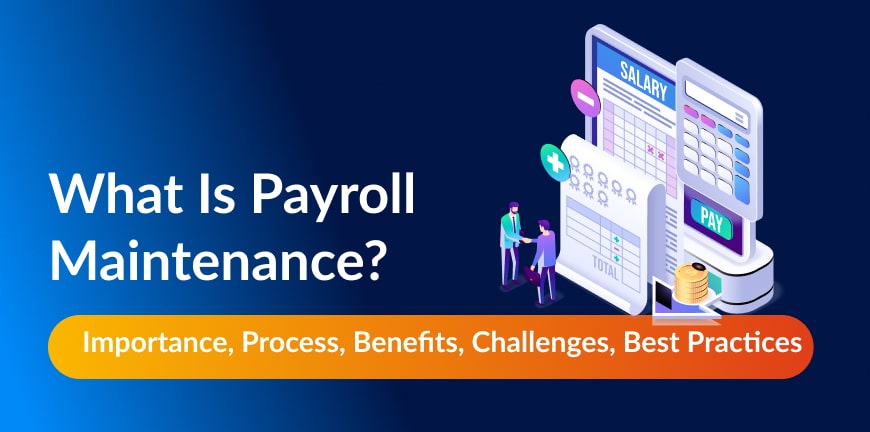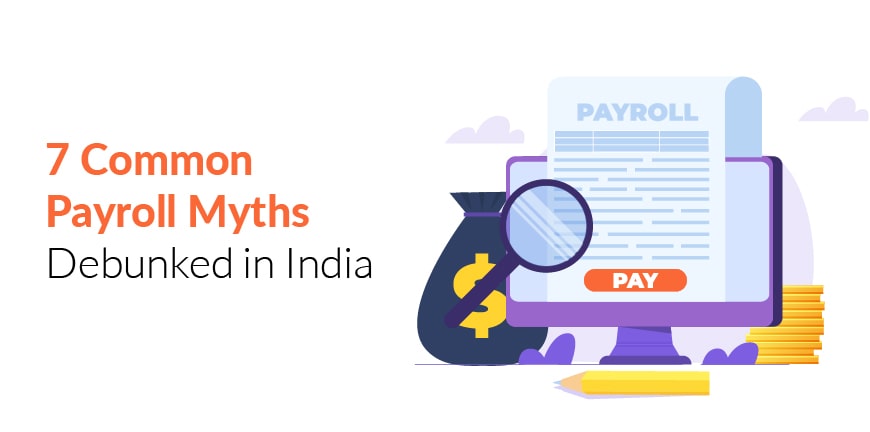
5 Reasons Why Indian IT Professionals are Moving to Japan
19/05/2025
Role of Employer Branding in White-Collar Talent Acquisition
20/05/2025- What is Payroll Maintenance?
- What is Payroll Maintenance Process?
- What are the Benefits of Payroll Maintenance?
- What are the Common Challenges in Payroll Maintenance?
- What are the Best Practices for Effective Payroll Maintenance?
- What are the Future Trends in Payroll Maintenance?
- Frequently Asked Questions (FAQs)
Previously payroll was just considered an HR activity where the salaries are calculated, and payments are credited monthly. However, the current scenario has completely changed, and payroll management is now a vital part of business growth strategy.
To ensure seamless payroll operations, payroll maintenance must be integrated on a full scale throughout the organisation. Let’s discuss all the aspects of payroll maintenance and gain valuable insights for its effective implementation.
What is Payroll Maintenance?
Payroll maintenance is a systematic process of calculating, managing, and maintaining employee payroll for an organisation. The key payroll maintenance activities include the calculation and prompt disbursal of wages, incentives, bonuses, tax withholdings and other deductions.
Payroll maintenance also involves leave management, payslip generation, and compliance management. The policies and procedures involved in the payroll maintenance process must align with labour laws and regulations and any errors arising must be mitigated on a priority basis.
What is the Importance of Payroll Maintenance?
Here are some of the reasons that illustrate the importance of maintaining payroll:
1. Error-free and timely payments
The effectiveness of payroll maintenance can be verified when employees receive their salaries on time with accurate benefits and deductions. Without a robust payroll maintenance mechanism, payment schedules will be disrupted leading to payroll errors and employee dissatisfaction.
2. Mitigation of potential risks and compliance
Payroll maintenance activities will help the companies identify and eliminate potential risks and discrepancies beforehand and ensure compliance requirements are fulfilled. The compliance team must perform regular audits (internal and external) to continuously improve the payroll maintenance process and achieve the best outcomes.
3. Streamline payroll operations
The payroll maintenance process is designed specifically to streamline payroll tasks by ensuring zero errors from calculation to reporting without creating delays in payment disbursal and other payroll-related activities. This will improve employee morale and ensure business continuity.
4. Maintain accurate documentation and record-keeping
Effective payroll maintenance will ensure accurate payroll records and documents are maintained. It is essential for employee data management, audits, and other compliance requirements.
5. Financial and Budget Planning
Payroll maintenance provides the necessary financial data for financial planning, budgeting, and forecasting.
What is Payroll Maintenance Process?
The key payroll maintenance process steps include:
1. Collect accurate employee data
The payroll maintenance team must collect accurate and complete employee data necessary to initiate payroll activities. The task involves accurate calculation of take-home salary, tax withholdings, job status (active or left the organisation), designation, etc.
2. Monitor employee working hours and leaves
The employee’s working hours, leave application and approval, overtime, sign-in and sign-out must be calculated and stored accurately in the payroll management system for further processing.
3. Gross pay calculation
The payroll maintenance consultants must calculate the gross pay of each employee based on working hours and applicable pay rates (either hourly or per day). Additionally, if overtime pay and incentives are applicable, then calculate the same using extra hours data and add the details in the payroll management system.
4. Calculate and deduct applicable taxes and other withholdings
The team must calculate and deduct applicable taxes like TDS, professional tax, etc based on applicable tax slabs and state-wise regulations. Also, other deductions like health insurance premiums, ESI, EPF, etc., must be computed for each employee as per the terms of employment.
5. Payment credit
Ensure each employee receives their take-home salary, overtime pay, and incentives to their designated bank accounts on time. Additionally, ensure each employee receives their payslips with breakups promptly without errors.
6. Compliance management
The payroll maintenance team must also ensure compliance requirements for payroll are met and that any discrepancies or errors are rectified on an immediate basis. Additionally, carry out period inspections and audits to assess and verify if the current payroll process is in line with the latest employment laws and regulations.
What are the Benefits of Payroll Maintenance?
The key benefits of payroll maintenance include:
- Effective payroll maintenance ensures 100% compliance is achieved, and companies can prevent fines, lawsuits, and multiple external audits.
- The payroll maintenance process helps in accurate calculation and maintaining records leading to enhanced employee satisfaction and accurate financial reporting.
- Employee will receive on-time payments which boosts their morale and improve productivity.
- By accurate tax withholding calculations and remittances, companies can improve their brand reputation and get further investments for business expansion.
- Payroll maintenance provides accurate financial data which can utilised for budgeting, financial planning, and other activities that require verified financial data.
What are the Common Challenges in Payroll Maintenance?
The common challenges encountered during the payroll maintenance process include:
1. Lacking awareness of the Latest Payroll Regulations
Payroll regulations are not consistent and are subjected to frequent updates and amendments from the Ministry of Labour and Employment and Income Tax Department. Sometimes companies find it very challenging to navigate and make process changes accordingly.
2. Payroll errors
No matter how much automation is integrated into a payroll management system, at least some manual intervention is required to execute certain tasks. Avoiding payroll errors becomes challenging requiring a lot of expertise and resource investment for quality control.
3. Accurate calculation of overtime and tax withholdings
Overtime pay calculations can be tricky since they involve hourly rates and other statutory factors. The applicable rates vary with designation, tax slab rates, and other elements making it difficult for the payroll maintenance team to make accurate calculations and add it to the gross pay.
4. Employee benefits management
Managing employee benefits like medical insurance, provident fund, incentives, etc., can be tricky and time-consuming for the payroll maintenance team. The calculations should be accurate and comply with the laws and regulations of employment laws. Balancing such payroll maintenance activities can be challenging and requires a lot of expertise to get the best results.
What are the Best Practices for Effective Payroll Maintenance?
Here are the best practices for effective payroll maintenance:
1. Maintain accurate employee data
Collecting and maintaining employee data is one of the key payroll maintenance activities. The payroll maintenance team must keep up-to-date and accurate records of employee data such as full name, current and permanent address, emergency contact, job title, job designation, salary details, tax withholdings, attendance, working hours, leaves, etc.
2. Ensure employee classification is accurate
Employee classification plays a crucial role in the payroll maintenance process since salary and tax calculations depend on it. The payroll team must classify employees based on exempt vs non-exempt, contract vs permanent, full-time vs part-time, etc., and then proceed with the payroll calculations as per classification details.
3. Be aware of the latest updates on payroll laws and regulations
The payroll maintenance team must conduct regular research and monitor labour law amendments and tax slab changes. Additionally, the team must keep a habit of visiting government websites to get the latest updates on the regulations related to the payroll process. Moreover, partnering with a top-pay maintenance agency like ALP Consulting can help streamline the payroll process and achieve the best outcomes.
4. Automate the payroll maintenance activities wherever possible
The payroll maintenance team must automate the payroll tasks wherever possible to reduce errors and increase the speed of the process. Using automated payroll management software can help to streamline operations and integrate them into other business operations. This strategy can help ensure compliance and save valuable time for all involved parties.
What are the Future Trends in Payroll Maintenance?
1. Payroll maintenance for building business strategies
Most organisations are considering payroll maintenance teams as strategic partners for workforce planning, compliance audits, and budgeting. The company will use the payroll employee data and outcomes to devise plans to improve employee experience and make informed decisions on future business growth plans.
2. Self Service in payroll maintenance
Companies are directing their efforts to create self-service portals for employees and payroll managers for effective management of the payroll process and to improve employee experience.
For employees: Companies are building automated payroll management systems where employees can track their work hours, apply for leaves, and PTO, download payslips, etc. This will reduce the burden on the HR team as well and they can concentrate on strategic planning rather than administrative tasks.
For payroll managers: They will gain more control like setting up payroll for new joiners and onboarding in a unified platform. The payroll management system will have self-service functions, payroll calendars, a digital onboarding mechanism, pay group creation, etc., making it easier for the payroll maintenance team to run their operations.
Frequently Asked Questions (FAQs)
1. What is included in payroll maintenance?
The key components of the payroll maintenance process include developing and maintaining payroll policies, calculating gross salaries and deductions, remitting tax to authorities, maintaining accurate payroll records, payment disbursal, payslip generation, reporting and filing tax returns, etc.
2. How often should payroll maintenance be performed?
The payroll maintenance timeline depends on the type of activities that are performed. Payroll calculations and disbursal, it is usually done monthly. Other tasks like auditing, tax report generation, payroll reconciliation, etc., are done once a year or as per company requirements.
3. What’s the difference between payroll processing and maintenance?
The payroll process involves day-to-day operations like managing attendance, calculating payment and tax withholdings, etc. Whereas payroll maintenance ensures all the payroll activities are maintained efficiently and records are maintained for each transaction related to payroll.
4. How much does payroll maintenance cost?
Payroll maintenance costs vary based on company size, frequency of the activities, whether an internal team or external agency is handling the payroll maintenance process, etc. Usually, partnering with a top payroll maintenance agency like ALP Consulting will be more cost-effective than forming an internal payroll maintenance team.
5. Can payroll maintenance be automated?
Yes, most payroll maintenance activities can be automated with the use of payroll management software and other integration technologies.
Contact Us For Business Enquiry

Yugandhara V. M
Yugandhara V. M serves as the Assistant Vice President – HRO at Alp Consulting Ltd., bringing over 14 years of rich experience in Human Resource Outsourcing, payroll management, and statutory compliance. He specializes in driving process excellence across HR operations, ensuring seamless service delivery and compliance with labor laws. Yugandhara’s expertise lies in managing large-scale client engagements, optimizing HR processes, and implementing efficient workforce management systems that enhance organizational performance. He also leads comprehensive payroll services, ensuring accuracy, timeliness, and compliance for diverse client portfolios.




